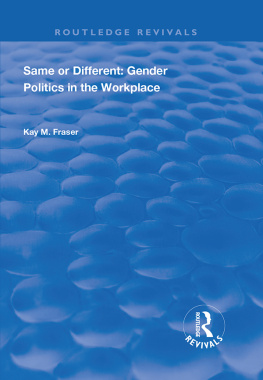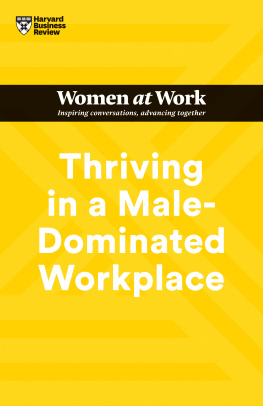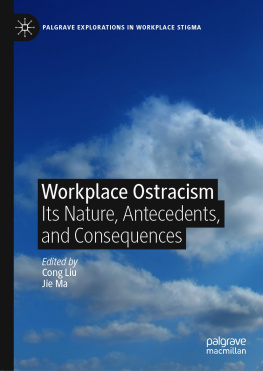SAME OR DIFFERENT: GENDER POLITICS IN THE WORKPLACE
First published 1999 by Ashgate Publishing
Reissued 2018 by Routledge
2 Park Square, Milton Park, Abingdon, Oxon, OX14 4RN
711 Third Avenue, New York, NY 10017, USA
Routledge is an imprint of the Taylor & Francis Group, an informa business
Copyright Kay M. Fraser 1999
All rights reserved. No part of this book may be reprinted or reproduced or utilised in any form or by any electronic, mechanical, or other means, now known or hereafter invented, including photocopying and recording, or in any information storage or retrieval system, without permission in writing from the publishers.
Notice:
Product or corporate names may be trademarks or registered trademarks, and are used only for identification and explanation without intent to infringe.
Publishers Note
The publisher has gone to great lengths to ensure the quality of this reprint but points out that some imperfections in the original copies may be apparent.
Disclaimer
The publisher has made every effort to trace copyright holders and welcomes correspondence from those they have been unable to contact.
A Library of Congress record exists under LC control number: 98074630
ISBN 13: 978-1-138-35188-2 (hbk)
ISBN 13: 978-0-429-43496-9 (ebk)
During the long process of putting this work together I have been helped by a number of people. There are a few who have been especially helpful and who require special thanks.
The women and men trade unionists who spent time talking with me on my visits to England not only provided me with the sort of background information to the 1960s that is impossible to find in written sources, but they also gave me inspiration and encouragement. My conversations with Betty Barber, Doreen Cook, Henry Friedman, Sheila Hall, Christine Page, Bemie Passingham, Rita Stephen, Lil Thompson, Meg Tritton, Pat Turner and Audrey Wise were central to the understanding I gained of the working conditions of the period.
The offices 1 invaded at the Department of Employment and the Trade Union Congress gave me invaluable source material. Both Jenny Trent in the Records Management Unit at the Department of Employment and Rosie Stone in the Filing Department at the Trades Union Congress showed extreme patience with my constant requests for just one more file.
From the University of Sydney, Australia I have learnt much and gained in many respects from the writing of this story. Carole Adams, Suzanne Jamieson and, particularly, Glenda Sluga have helped me at different times and in various ways.
At a personal level I am very grateful to Peace Thom, who has always been available to listen to me. To Ian Fraser I owe a considerable debt. Without his support and encouragement this book would not have been possible.
| AEU | Amalgamated Engineering Union |
| CAWU | Clerical & Administrative Workers Union |
| CBI | Confederation of British Industry |
| COI | Central Office of Information |
| CSEU | Confederation of Shipping and Engineering Unions |
| DE | Department of Employment |
| EEC | European Economic Community |
| EWOW | Employment of Women and Older Workers |
| GTC | Government Training Centres |
| ILO | International Labour Organisation |
| MRC | Modem Records Centre |
| NEDC | National Economic Development Council |
| NJACCWER | National Joint Action Campaign Committee for Womens equal Rights |
| NUGMW | National Union of General & Municipal Workers |
| OECD | Oganisation for Economic Co-operation and Development |
| OPCS | Office of Population Censuses & Surveys |
| PRO | Public Record Office |
| TGWL | Transport & General Workers Union |
| TUC | Trades Union Congress |
| USDAW | Union of Shop, Distributive & Allied Workers |
| WAC | Womens Advisory Committee |
| WCC | Womens Consultative Committee |
In the summer of 1968 approximately 300 women sewing machinists began a strike at the Ford Motor Company in Britain which eventually brought the daily production of 2,200 cars to a complete halt. The machinists went out on strike to obtain recognition for what they saw as their skilled machine work. They wanted an upgrading in the formal status accorded them within the grading structure of the company. Rosie Boland, one of the shop stewards for the women explained at the time. 'What we're concerned with is proving that we are skilled workers'. The higher grading would have acknowledged both the physical skills of the women - that is, the speed and accuracy they were capable of producing on a sewing machine - and their eligibility to be considered as skilled workers. The machinists were in effect claiming that the company had not given their job of making the seat covers for the Ford motor car proper recognition.
Although the strike was only 21 days in duration it has claimed a place in British labour history because it became a rallying point for the claim for equal pay for women in Britain during the late 1960s.
Yet the outcome of the strike was a disappointment to the women strikers. Although they eventually received what was termed equal pay and were immediately given a 7d per hour wage increase they did not obtain the higher grading they had demanded. The Ford Motor Company's promise of equal pay and the provision of an immediate wage rise seemed to suggest recognition for the value of the machinists' work. However, the sewing machinists remained in the lower grade B alongside male production workers on the assembly line - men in non-skilled jobs - for another fifteen years. As in most questions about equality, it was a matter of 'equal to whom'. The company had designated the machinists equal to a group of workers who were not required to pass a 'test' of skill as was asked of the women sewing machinists. Ten years after the strike Lil OCallaghan, another shop steward, said: 'The girls felt they were in B Grade because of sex discrimination ... it wasn't the money, it was the principle involved - our skill was not recognised, and we are skilled ...Today, we still say it isn't fair' (Friedman and Meredeen, 1980). Lil O'Callaghan was insisting that the quality and stature of the sewing machinists' paid employment was undervalued because they were women. But more than that, the machinists' claim for 'skilled worker' recognition was lost in the popular approval given to the demand for equal pay and its implicit promise of equality between women and men workers.
This brief outline of the circumstances surrounding the Ford women's strike raises the general question that is central to this book: how are the worker demands made by women to be heard and understood in workplace negotiations? Even in the late 1990s there are many women workers whose needs and concerns remain hidden behind a workplace agenda dominated by male interests. The call made by the sewing machinists in 1968. for an acknowledgment of their particular skill and value to industry, was a demand that they be accepted as workers in the same way as men. The machinists were not saying that their skills were the same as men workers, they were suggesting that their different worker skills and attributes deserved recognition as were the worker skills of men - with a high grading. But the attempt by the sewing machinists to articulate their worker difference went unnoticed. Instead, their demand for recognition as skilled workers was overshadowed by the apparently more potent claim for equal pay made by the male rank and file leadership. At the time the idea of equal pay for industrial women workers was gaming prominence in workplace negotiations within industry and was directly linked to the popular expressions being made in British society generally about the possibility of women gaining economic equality with men. Underlying the idea of equal pay, however, was an assumption that women workers were the same as men and the rejection of a notion of difference which, since the earliest years of the nineteenth- century, had designated 'womens work as secondary to the work of men. Yet even with equal pay the sewing machinists felt discriminated against. Was it not possible to be different from and the same as men in the sense implied by the sewing machinists? Why were the sewing machinists' voices lost to a notion of equality which appeared ineffectual? Further, what made equal pay such a powerful and influential issue?





